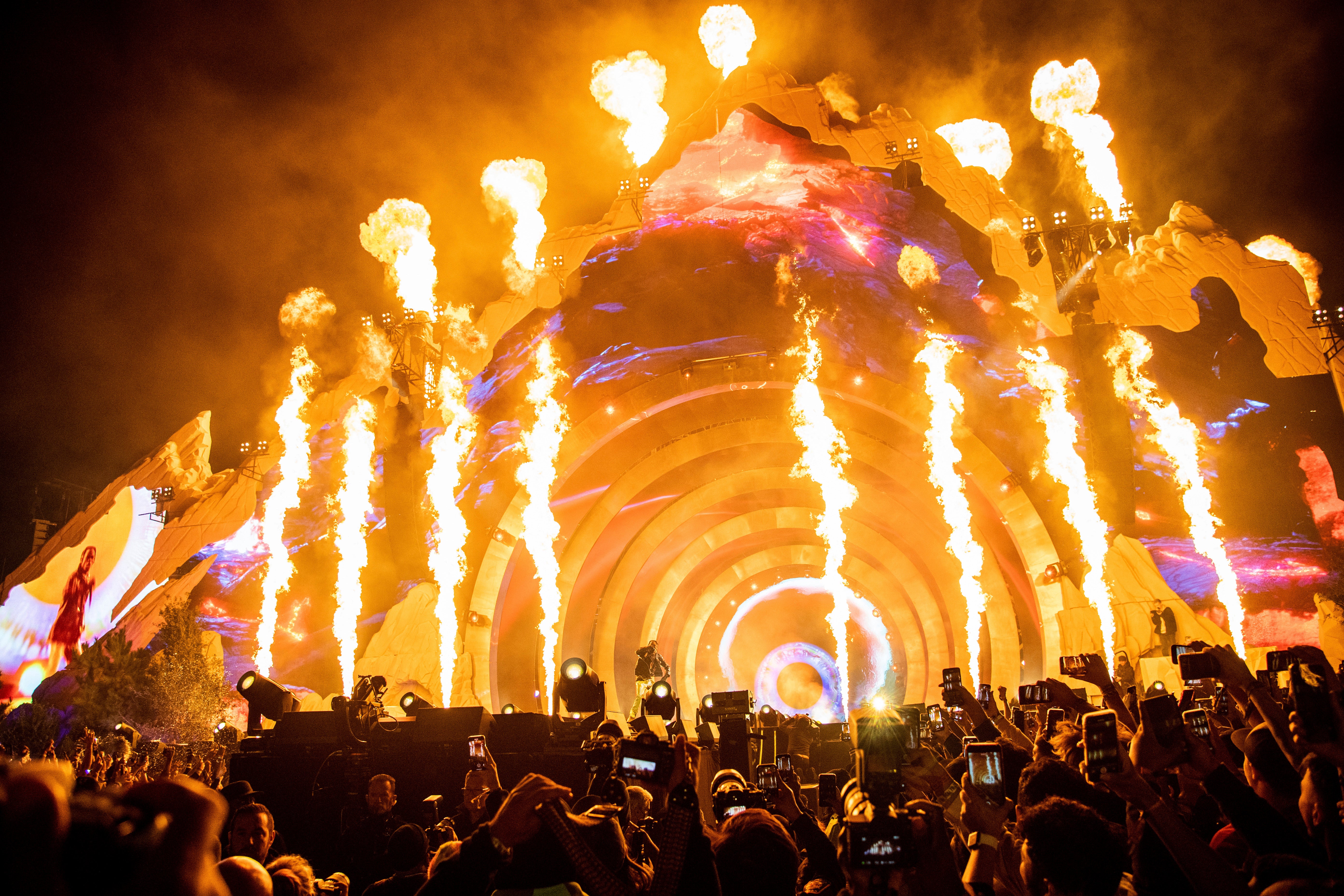Astroworld: How bogus ‘satanic panic’ conspiracy theories are hijacking a senseless tragedy
From The Beatles to Tupac Shakur, musicians have long been charged with inciting ‘satanic panic’, Bevan Hurley writes

The Astroworld tragedy has sparked a torrent of conspiracy theories across every social media platform, from the spurious claim that Travis Scott’s management company deliberately planned the mass casualty event to a bizarre anti-vax theory.
The most popular of these conspiracies is that the tragic death of eight young people at NRG Park last Friday was a Satanic ritual, with TikTok clips promoting the claim having collectively racked up tens of millions of views.
Disinformation experts say the link between Mr Scott and “demonic spirits” has its roots in popular culture tropes, America’s complex history with race, and the increasing inability of young people to discern fact from fiction.
The first TikTok clips suggesting Mr Scott was indulging in “ritual sacrifice” emerged within hours of news of the tragedy breaking last Friday night.
Typical of these viral TikToks is one which says the concert stage was “an inverted cross leading to a portal to hell”, which has been viewed millions of times.
According to Joseph Russo, who teaches a class on the anthropology of conspiracy theories at Wesleyan University in Connecticut, the “Satanic panic’ trope first rose to prominence in the 1960s when The Beatles were accused of trying to influence America’s youth through subliminal messaging on their records.
“We have a tradition of connecting popular culture figures to some kind of dark secret society underneath,” Mr Russo said.
In the ‘80s and ‘90s, many early pioneers of rap and hip-hop embraced conspiracy theories and featured them heavily in their lyrics, Mr Russo said.
References to the 1991 book Behold a Pale Horse by William Cooper, a bible for modern day conspiracists, was referenced by musicians such as Tupac Shakur, Public Enemy and Busta Rhymes.
Mr Russo said it made sense for African-American artists to look for “alternative narratives”, given their experiences with oppression and racism.
“The history of Black people in the United States is a very tragic history, a very violent history. (Conspiracy theories) have a kind of rational underpinning.”
Mr Russo sees parallels between the Astroworld controversy playing out on social media and the QAnon movement, whose followers see Donald Trump as a messianic figure who has been sent to arrest a cabal of paedophilic celebrities and Democrats.
“Any major event of crisis or senseless tragedy immediately gets folded into the current conspiracy theory story which I see as being very connected to QAnon,” he said, citing the 2017 Las Vegas massacre, which has become part of QAnon folklore.
“A lot of this does come back to white anxiety, and Trump tapped into that very successfully.”
Since the advent of social media, platforms like Facebook have been used to spread disinformation faster and to much larger audiences than ever before.
That habit of sharing memes on Facebook has found a new audience among Gen-Zers on TikTok.
“It’s the same content with a new form,” Mr Russo said.
Much of the focus of the TikTok hysteria has homed in on the stage layout, and Scott’s concert opening which featured a hologram of a bat-like flying object that was surrounded by eight large shooting flames.
“This is pure evil,” one commenter wrote on a video, which has attracted 77,000 likes. Commenters claimed the eight flames were a reference to the eight fatalities.
Mr Russo said it appeared the set designers had deliberately tried to create a “somewhat demonic aesthetic”.
Festivalgoers entered the arena through a gateway shaped like Scott’s mouth, with many comparing it to the 1575 painting Christ in Limbo by a follower of Dutch artist Hieronymous Bosch.
“It’s not crazy to think the design team really have their finger on the pulse of culture, how people are going to talk about this and how people are going to show it on TikTok,” he said.
Yotam Ophir, an assistant professor of the Media Effects, Misinformation, & Extremism Lab at the University of Buffalo, said conspiracy theories often took a devastating toll on grieving families.
“Here for example, parents who’ve lost their loved ones should now also fight off malicious claims that their children were not merely concertgoers but satanic worshipers.”
He compared the Astroworld conspiracies to the 2012 Sandy Hook school shooting, when grieving parents were “harassed by Alex Jones and other conspiracy theory personalities, and had to cope with both the loss of their children and the consistent harassment online and in real life.”
They were often deliberately employed to distract people from real-world problems with bogus narratives.
“We tend to believe that very dramatic events must be the result of very dramatic circumstances, for example a plot to turn a concert into a satanic ritual as part of an eternal war between good and evil.”
Dr Ophir said conspiratorial content was engineered to spread quickly across social media. Platforms couldn’t be relied on to reign in the problem, and so greater regulation was needed.
“Instead of hoping that social media conglomerates like Facebook and YouTube will clean up misinformation and stop the spread, we need to take steps to educate people how to cope with the extremely complicated and saturated information environment, and regulate social media, like we did with pretty much every media company before.
“We need to build a sustainable legal system to fight misinformation and its devastating impact on individuals and societies.”
Subscribe to Independent Premium to bookmark this article
Want to bookmark your favourite articles and stories to read or reference later? Start your Independent Premium subscription today.

Join our commenting forum
Join thought-provoking conversations, follow other Independent readers and see their replies